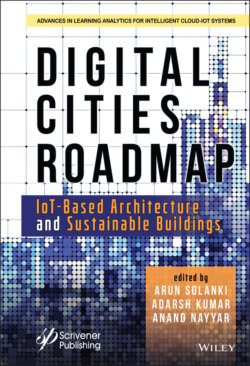Читать книгу Digital Cities Roadmap - Группа авторов - Страница 42
1.10.3 Level if Clouds are the IoT Institute Level With SBs
ОглавлениеTo order to maintain optimum monitoring and activity of the design, the IoT enables the convergence Interconnection and transfer of data processing capacities in embedded devices to SBs in high definition. IoTs are based on a layer-dependent design as seen in Figure 1.21. Data collected from different sensing devices is obtained, which are able to track environmental conditions, gather data on the civilian community and identification of disturbances (e.g., bursts of flames and water pipes). This layer also contains actuators to be monitored for energy conservation, water usage minimization and so on.
In the network layer (second layer in Figure 1.21), there is a clear access and core networking potential. This layer is used to link the smart grid with the top layers accountable for the processing of data. An intermediate software layer known as the middleware layer (the third layer in Figure 1.21) is required to incorporate the design sensing layer smoothly into heteroscope devices and networks. The layer acts as a link between the embedded devices operating intelligent sensors and network backend services.
The context and the somaticized discovery layer (Figure 1.21, fourth layer) is responsible for the management of context and semanticized discovery, including context and semanticization generation. The analysis and reasoning layer (fifth layer in Figure 1.21) processes extracted knowledge from the middleware and takes decisions according to the application level. Various information retrieval systems are implemented in this layer to combine, retrieve and contextualize massive knowledge into practical know-how.
Figure 1.21 IoT smart resilience building architecture.
These included exceptional facilities and initiatives, an OSI model (Figure 1.20’s biggest layer). This layer offers a context with clear links to the fundamental functions for various forms of applications. In addition, panels for managing automatic, the residence will create confined environments and infrastructure for a regional human–computer interface. The residence will create confined environments and infrastructure for a regional human–computer interface.
Knowledge and the retrieval of information in the sense of implementation and decision-making and the last layer of operation, including health care and home elderly care, convenience and entertainment facilities, protection, tele-management, intelligent watering, and resource output etc. analyze the core features of residential and industrial structures.
